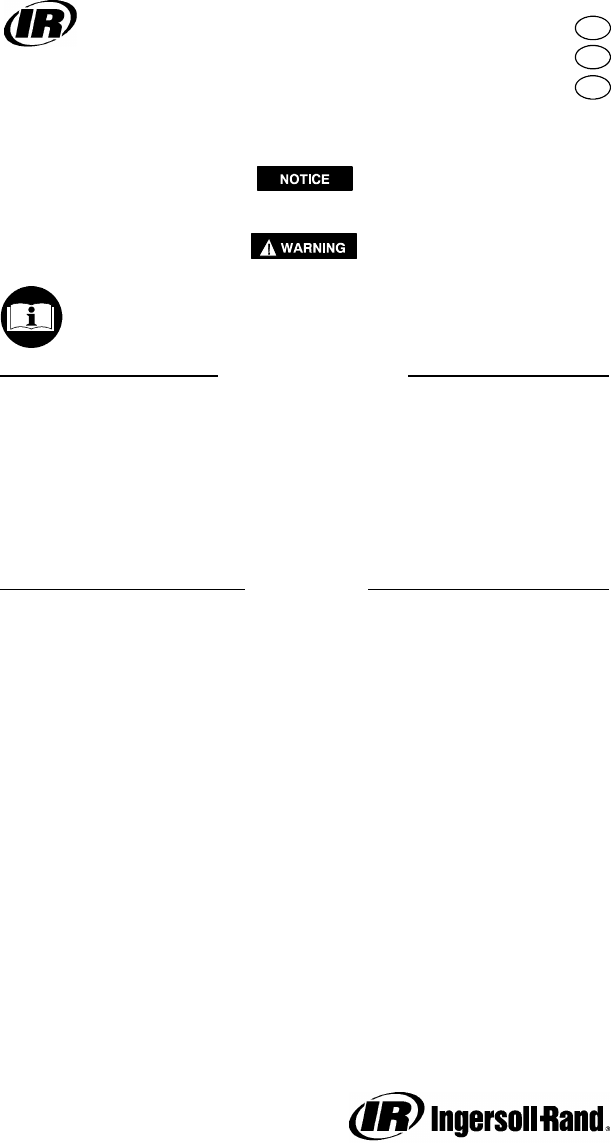
Refer All Communications to the Nearest
Ingersoll--Rand Office or Distributor.
Ingersoll--Rand Company 2002
PrintedinU.S.A.
04577441
Form P7470
Edition 2
December, 2002
OPERATION AND MAINTENANCE MANUAL
FOR MODEL 232TGSL (THUNDER GUN STREET LEGAL)
1/2” IMPACT WRENCH
Model 232TGSL Impact Wrench is designed for use in general automotive repair, body
shops, front end service and light truck and farm equipment applications.
IMPORTANT SAFETY INFORMATION ENCLOSED -- SAVE THESE INSTRUCTIONS
READ AND UNDERSTAND THIS MANUAL BEFORE OPERATING THIS PRODUCT
IT IS YOUR RESPONSIBILITY TO MAKE THIS SAFETY INFORMATION
AVAILABLE TO OTHERS THAT WILL OPERATE THIS PRODUCT
FAILURE TO OBSERVE THE FOLLOWING WARNINGS COULD RESULT IN INJURY
PLACING TOOL IN SERVICE
• Always install, operate, inspect and maintain this
product in accordance with all applicable standards
and regulations (local, state, country, federal, etc.).
• Always use clean, dry air at 90 psig (6.2 bar/620 kPa)
maximum air pressure at theinlet. Higher pressure
may r esultin hazardous situations including excessive
speed,rupture,or incorrectoutputtorqueor force.
• Be sureall hoses and fittingsare thecorrect size and
aretightly secured.See Dwg. TPD905--2 fora typical
piping arrangement.
• Ensure anaccess ible emergency shutoff valvehas
been installed inthe air supplyline, andmake others
awareof its location.
• Do not use damaged, frayed ordeteriorated air hoses
and fittings.
• Keep clear ofwhipping air hoses. Shutoff the
compressed airbefore approaching a w hippinghose.
• Always turn off the airsupply and disconnect the air
supply hose bef ore installing,removing oradjusting
any accessory onthis tool, orbefore performing any
maintenance onthis tool.
• Do not lubricate tools withflammable or volatile
liquidssuch as kerosene,diesel orjet fuel.Use only
recommended lubricants.
• Keep work areaclean, uncluttered, ventilated and
illuminated.
• Do notremove anylabels. Replace any damagedlabel.
USING THE TOOL
• Alwayswear eye protectionwhenoperatingor
performing maintenance on this tool.
• Always wearhearing protectionwhen operatingthis
tool.
• Always usePersonalProtective Equipment
appropriate tothe tool used andmaterial worked.
This may includedust maskor other breathing
apparatus, safety glasses,ear plugs, gloves, apron,
safety shoes, hard ha tand other equipment.
• Prevent exposure andbreathing ofharmful dustand
particles created by po wer tool use.
Some dust created bypower sanding, sawing,
grinding, drilling,and other construction
activities contains chemicals knownto cause
cancer,birthdefects or otherreproductive harm.
Someexamplesof thesechemicalsare:
-- leadfrom leadbased paints,
-- crystalline silica frombricks and cementand
other masonry products, and
-- arsenic and chromiumfrom chemically
treated lumber.
Yourrisk fr omthese exposures varies, depending
on howoften youdo this typeof work.T oreduce
your exposure to these chemicals:work ina well
ventilatedarea, andwork withapproved safety
equipment,such as those dust masks that are
specially designed tofilter out microscopic
particles.
• Keep others asafe distance fromyour work area, or
ensure theyuse appropriate Personal Protective
Equipment.
• This toolis not designed forworking in explosive
environments,including thosecaused by fumes and
dust, ornear flammable materials.
• This toolis notinsulated againstelectric shock.
• Be aware ofburied, hidden orother hazardsin your
work environment.Do notcontact ordamage cords,
conduits, pipes or hoses thatmay contain electrical
wires, explosivegases orharmful liquids.
• Keep hands,loose clothing,long hair andjewelry
away fromworking endof tool.
• Power tools canvibrate inuse. Vibration,repetitive
motions or uncomfortable positions may be harmful
to your hands and arms. Stop using anytool if
discomfort, tinglingfeeling orpain occurs. Seek
medical advice before resuminguse.
• Keep body stancebalanced andfirm. Donot
overreachwhenoperatingthis tool.Anticipateand be
alert for suddenchanges inmotion, reaction torques,
or forces duringstart upand operation.
• Tooland/oraccessories maybrieflycontinuetheir
motion after throttleis released.
• Toavoid accidentalstarting -- ensuretool is in“off”
position beforeapplying airpressure, avoidthrottle
when carrying,and release throttle with loss ofair.
• Ensure workpieces aresecure.Use clamps or visesto
hold workpiece whenever possible.
• Do not carry ordrag thetool bythe hose.
• Do notuse power toolswhen tir ed,or under the
influence of medication, drugs, or alcohol.
• Never usea damagedor malfunctioningtool or
accessory.
F
E
P


















